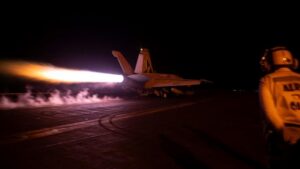GS II- International Relations

The United States recently launched over 40 precision strikes against Houthi positions in Yemen.
Reasons Behind US Military Action Against the Houthis
- Disruptions in the Red Sea: Since December 2023, Houthi attacks have severely impacted maritime trade, forcing shipping routes to bypass Africa, escalating insurance costs.
- Policy Continuity: The Biden administration classified the Houthis as Specially Designated Global Terrorists in 2024, and the Trump administration later reinstated their status as a Foreign Terrorist Organization (FTO) in 2025.
- Iran’s Alleged Role: Former President Trump equates Houthi aggression to direct Iranian hostilities, warning Tehran of possible repercussions.
- Connection to the Gaza Conflict: The intensity of Houthi operations escalated following Israel’s renewed military action in Jabalia.
- Ensuring Maritime Security: Maintaining free navigation in global waterways remains a key objective of US naval strategy.
Trump’s Strategic Intentions
- Avoiding Direct Conflict with Iran: Targeting the Houthis serves as a deterrent to Tehran without engaging in a full-scale war.
- Exerting Pressure on Iran: Trump’s rhetoric seeks to bring Iran to the negotiating table, particularly concerning its nuclear program.
- Domestic and Geopolitical Messaging: Reinforcing a tough stance on Iran aligns with Trump’s broader foreign policy and political narrative.
Houthis’ Military Strength and Resilience
- Survived Prolonged Aerial Bombardments: Despite enduring approximately 20,000 airstrikes by the Saudi-led coalition between 2015 and 2023, the Houthis remain operational.
- Effective Asymmetric Warfare: Employs mobility, modular combat strategies, and tactics inspired by Hezbollah’s engagements with Israel.
- Advanced Arsenal & Sustained Operations: Initially lacking missile capabilities before 2015, the Houthis have since developed sophisticated drone, rocket, and missile systems, maintaining offensive capabilities despite continuous foreign airstrikes.
International Support for the Houthis
- Iran: Serves as the primary financial and logistical supporter, though it publicly denies direct control over Houthi operations.
- China: Indirectly funds the Houthis by purchasing nearly 90% of Iran’s oil exports. Many Houthi anti-ship missiles are reportedly modeled after China’s C-802 series.
- Russia: Allegedly provides intelligence, small arms, and possibly anti-ship missile systems.
Challenges for the US in Countering the Houthi Threat
- Resilient Military Capabilities: Airstrikes weaken but fail to eliminate the Houthis’ ability to launch attacks.
- Complex Regional Dynamics: Limited backing from key Middle Eastern allies complicates sustained US intervention.
- Strategic Backing from Iran, Russia, and China: External support continues to strengthen the Houthis, making military pressure less effective in neutralizing their threat.




